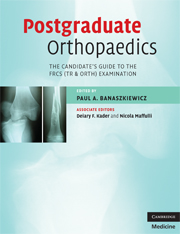Book contents
- Frontmatter
- Contents
- List of contributors
- Foreword by Mr Peter Gibson
- Preface
- Glossary
- Section 1 The FRCS (Tr & Orth) examination
- Section 2 The written paper
- Section 3 The clininicals
- 3 The short cases
- 4 Short case list
- 5 The long cases
- 6 Long case list
- 7 Hand and wrist clinical cases
- 8 Shoulder and elbow clinical cases
- 9 Spine clinical cases
- 10 Hip clinical cases
- 11 Knee clinical cases
- 12 Foot and ankle clinical cases
- 13 Paediatric clinical cases
- Section 4 Adult elective orthopaedics oral
- Section 5 The hand oral
- Section 6 The paediatric oral
- Section 7 The trauma oral
- Section 8 The basic science oral
- Section 9 Miscellaneous topics
- Index
- References
8 - Shoulder and elbow clinical cases
from Section 3 - The clininicals
Published online by Cambridge University Press: 22 August 2009
- Frontmatter
- Contents
- List of contributors
- Foreword by Mr Peter Gibson
- Preface
- Glossary
- Section 1 The FRCS (Tr & Orth) examination
- Section 2 The written paper
- Section 3 The clininicals
- 3 The short cases
- 4 Short case list
- 5 The long cases
- 6 Long case list
- 7 Hand and wrist clinical cases
- 8 Shoulder and elbow clinical cases
- 9 Spine clinical cases
- 10 Hip clinical cases
- 11 Knee clinical cases
- 12 Foot and ankle clinical cases
- 13 Paediatric clinical cases
- Section 4 Adult elective orthopaedics oral
- Section 5 The hand oral
- Section 6 The paediatric oral
- Section 7 The trauma oral
- Section 8 The basic science oral
- Section 9 Miscellaneous topics
- Index
- References
Summary
Acromioclavicular joint arthritis
The AC joint may be prominent due to osteophytes or a type III or V ACJ dislocation. The patient will point to the joint if it is the cause of the pain. Direct palpation can reveal well localized tenderness and crepitus over the AC joint. Shoulder movement is rarely restricted although in long-standing cases mild restriction of internal rotation and/or cross body adduction may occur. Provocative tests such as reaching across to touch the opposite shoulder or placing the hand behind the back may cause discomfort.
Cross body (horizontal) adduction test. The patient's arm on the affected side is elevated to 90° and the examiner grasps the elbow and adducts the arm across the body. Simultaneously the examiner's thumb pushes the lateral end of the clavicle anteriorly. Reproduction of pain over the AC joint is suggestive of AC joint OA but not specific. The test may be positive in patients with subacromial impingement.
When full movement of the shoulder is possible a terminal impingement pain (pain above 120°) can be demonstrated on both active and passive movement. Differential diagnosis would include calcific tendinitis, early adhesive capsulitis and glenohumeral arthritis. Discussion may include description of the radiographic findings and management of the condition. Surgery would usually be arthroscopic distal clavicle resection either by a subacromial (indirect) approach or a superior (direct) approach.
- Type
- Chapter
- Information
- Postgraduate OrthopaedicsThe Candidate's Guide to the FRCS (TR & Orth) Examination, pp. 51 - 63Publisher: Cambridge University PressPrint publication year: 2008



